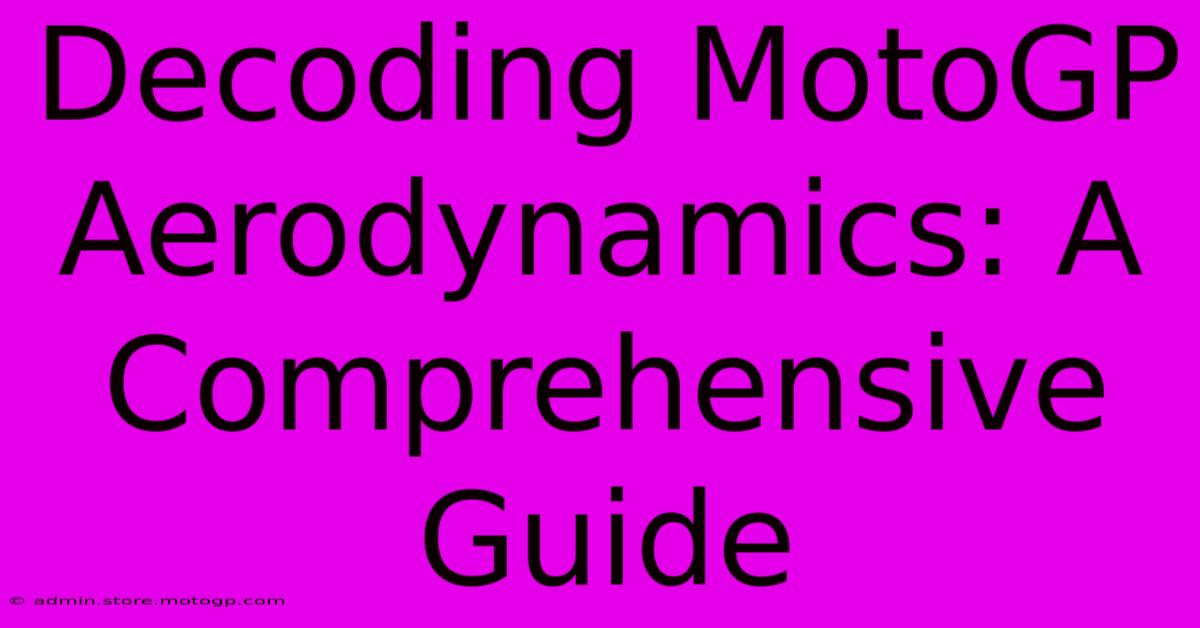Decoding MotoGP Aerodynamics: A Comprehensive Guide

Table of Contents
Decoding MotoGP Aerodynamics: A Comprehensive Guide
MotoGP racing isn't just about horsepower and rider skill; it's a finely tuned dance of aerodynamics. Understanding the complex interplay of air and machine is crucial to appreciating the sport's cutting-edge technology and the intense competition it fosters. This comprehensive guide delves into the world of MotoGP aerodynamics, explaining the key components and their impact on performance.
The Aerodynamic Arms Race: Why it Matters
Modern MotoGP bikes generate incredible speeds, and at those velocities, even small aerodynamic improvements translate to significant gains in lap times. Aerodynamics affects several key areas:
- Downforce: Crucial for high-speed cornering stability. More downforce means the bike grips the track better, allowing riders to lean further and carry more speed through turns.
- Drag Reduction: Minimizing air resistance is vital for maximizing straight-line speed. Less drag means the bike accelerates faster and reaches higher top speeds.
- Stability: Aerodynamic elements help to stabilize the bike at high speeds, reducing the chances of high-side or low-side crashes.
- Rider Comfort: While often overlooked, aerodynamic design can affect rider comfort and fatigue, impacting performance over the course of a race.
Key Aerodynamic Components
Several components contribute to a MotoGP bike's aerodynamic performance:
1. Fairings: The Foundation of Aerodynamics
The fairing is the motorcycle's outer shell, meticulously designed to manage airflow. Its shape, specifically the leading edge and trailing edge, dictates how air flows around the bike. Modern fairings are often highly sculpted, utilizing complex curves and surfaces to optimize downforce and minimize drag.
2. Winglets: Generating Downforce
Winglets, small wing-like structures, are prominent features of modern MotoGP bikes. These generate downforce by creating a pressure difference above and below the wing, pushing the bike down onto the track. Their placement and design are crucial for their effectiveness and are constantly being refined by teams. Different winglet configurations are used depending on the track's characteristics.
3. Aero-Wings: Advanced Downforce Solutions
Beyond winglets, some MotoGP bikes incorporate larger, more complex aero-wings. These provide significantly greater downforce but also increase drag. Teams must carefully balance the benefits of increased downforce against the potential loss of straight-line speed. The sophisticated design often includes adjustable elements to optimize performance for different track conditions.
4. Underbody Aerodynamics: Harnessing the Underside
The underside of the bike is also crucial for aerodynamic performance. Smooth underbody panels and carefully designed airflow channels help to manage airflow, reducing drag and potentially generating downforce. The underbelly area is often a crucial element in design optimization.
5. The Influence of the Rider: A Dynamic Factor
The rider's position also plays a role in aerodynamics. A tucked position minimizes drag, while a more upright posture can increase stability at lower speeds. Rider input into the machine's design and performance are a crucial factor in achieving the optimal balance of performance and stability.
The Continuous Evolution of MotoGP Aerodynamics
MotoGP aerodynamics is a constantly evolving field. Teams employ advanced computational fluid dynamics (CFD) simulations and wind tunnel testing to refine their designs. New regulations and technological advancements continuously push the boundaries of aerodynamic performance, leading to an ongoing arms race among teams.
The Future of MotoGP Aerodynamics: We can expect even more sophisticated aerodynamic solutions in the coming years, potentially including active aerodynamic elements that adapt to changing conditions in real-time.
Conclusion: A Symphony of Speed and Science
Understanding the role of aerodynamics in MotoGP is key to appreciating the incredible engineering and technological prowess of the sport. The intricate balance between downforce, drag, stability, and rider comfort represents a fascinating blend of science and competition. As technology continues to advance, the aerodynamic battles on the track promise to become even more captivating.

Thank you for visiting our website wich cover about Decoding MotoGP Aerodynamics: A Comprehensive Guide. We hope the information provided has been useful to you. Feel free to contact us if you have any questions or need further assistance. See you next time and dont miss to bookmark.
Featured Posts
-
The Art Of Cornering Mastering Motorbike Racing Techniques
Feb 19, 2025
-
The Future Of Moto Gp Live On Tnt Sports
Feb 19, 2025
-
The Mental Game Of The Best Moto Gp Riders
Feb 19, 2025
-
Choosing A Moto Gp Helmet Safety Style And Performance
Feb 19, 2025
-
The Moto Gp Crash That Shocked The World
Feb 19, 2025
